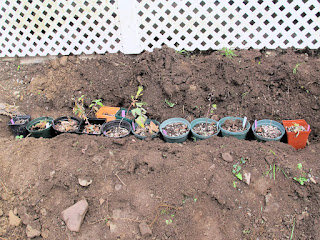Posted by Sarah Schweig, Broomfield County Extension
You may have perennials in containers rather than in the ground for a number of reasons. Perhaps you incorporated them into patio plantings, or maybe they were bought with the intention of planting them, but you didn’t get around to it. Either way, you’ll need to protect most containerized perennials if you want them to survive the winter.
The USDA Plant Hardiness Zone on your plant tag is based on the plant’s ability to survive winters in the ground, and if you want to rely on hardiness zones, you should look two zones colder than your area when considering plants in containers. For reference, we are Zone 6a here in Broomfield, based on average minimum temperatures from -10ºF to -5ºF annually. For two zones colder, think more like parts of Grand County or Park County in Zone 4a, which has average minimum temperatures of -30ºF to -25ºF. Add the fact that hardiness zones are based on 30-year averages (would anyone classify Colorado weather as predictable?), and it’s important to note that even plants rated for two zones colder are no guarantee for winter survival in containers. That said, there are strategies for protecting your perennial containers, and the more hardy the plant, the better their chances of survival.
By digging containers into soil, you can get the same insulative protection for roots that they would get if planted in the soil. Water plants before setting in the ground, and dig holes deep enough for plants to sit at the same level they would if planted in the ground. Mulch heavily for added protection.
Drying winds and temperature fluctuations are as much an issue as low temperatures when it comes to winter survival. Soil heaving can occur when soils freeze and thaw repeatedly, potentially breaking roots or exposing sensitive parts of the plant. Larger containers can help mitigate soil desiccation and temperatures and therefore increase chances for winter survival. You can also simulate this positive effect by grouping containers together. Allow the containers to protect each other by placing larger containers on the outside of the huddle and smaller containers on the inside. Get added protection by placing in an area protected from wind and mulching around and over the tops of the pots.
Unheated indoor spaces like garages or sheds are another option. Many perennials require annual cold temperatures and a dormancy period, so this space should ideally stay around 30º - 40ºF, warm enough to protect from injury and cold enough for vernalization. Don’t forget to check on plants stored indoors periodically and water when dry.
For all of these options, continue to water plants until soil freezes, and water throughout the winter when temperatures are above 40ºF. It’s important to keep an eye on your containers as temperatures begin to warm and stabilize in the spring. You don’t want to expose plants too quickly to environmental conditions. On the other hand, if protection remains in place too long, plants could start their spring growth prematurely. For those stored indoors, begin to bring outside when night time temperatures are around freezing. Late cold snaps may require bringing the pots back in temporarily, but it’s a small price to pay if they’ve made it that far. For pots huddled together in a protected outdoor location, begin to remove mulch gradually over a number of weeks as the weather warms. For pots sunk in the ground, remove them at the early signs of new growth to avoid their roots growing into the surrounding soil.



thanks -- very helpful.
ReplyDeleteGreat information! I shred my leaves in the fall and pack them in between and over the pots i am overwintering. Then I take any bags (compost, topsoil, mulch, etc) and ring the pots with the bags.
ReplyDelete